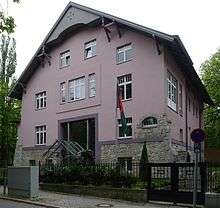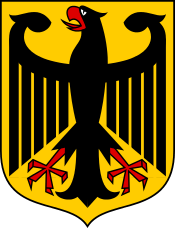Afghanistan–Germany relations
 |
|
Afghanistan |
Germany |
|---|---|

The Treaty of Gandomak (26 or 30 May 1879) and the Treaty of Durand Line overruled an prior agreement from 1893 concerning 2,640 kilometres (1,640 mi) of porous border between India (now between Pakistan) and Afghanistan. As a result of this treaty Britain gained full control of Afghan foreign policy from the King of Afghanistan. Germany, as a rival to Britain, was only able through secret missions and expeditions to reduce British influence in Afghanistan.
Engineer Gebhard Fleischer, nicknamed The german James Bond in Kabul,[1] was an engineer of the Krupp company, a German arms manufacturer. In 1893 he traveled to Kabul and privately met with the King Abdur Rahman Khan. Under the Kings orders he expanded the afghan weapons companies Maschin Khana (House of machines) and Tupkhana (cannon house). It is not sure whether the government in British India knew of this journey. Later, in 1904, the Krupp engineers were mysteriously assassinated. Adamec writes:
The first German known to reside in Kabul was Gottlieb Fleischer, an employee of Krupp Stellworks of Essen, Germany, who was contracted by Amir Abdul Rahman in 1898 to start manufacture of ammunitions and arms in the newly constructed factory (mashin Khana) at Kabul. He was killed in November 1904 near the border while traveling to India.[2]
Beginning and development of the relationship
Trade and friendship treaty of 1916
The relations between Germany and Afghanistan began before World War I. Relations between these two countries have historically been friendly.[3]
The second German-Afghan meeting between Habibullah Khan and a 23-member German delegation took place in 1915. The main intentions of this delegation was to weaken British influence in Afghanistan as part of the Niedermayer-Hentig expedition.[4] However, during this expedition in 1916 a friendly trade-agreement occurred.[5] The trade contracted concluded even though there were prior diplomatic relations between these countries. According to the Treaty of 24 January 1916 the German delegation to the Government of Afghanistan was promised 100,000 rifles and 300 guns.[6]
A friendship agreement was made on March 3, 1926.[7] With recognition of the ambassadors in both these countries. In 1926 the prior existing friendship and trade agreement of 24 January 1916 was ratified.
Diplomatic relations and accreditation of consul and ambassadors 1922
The first Afghan delegation to Germany occurred in 1922 where the delegation traveled to Berlin for talks on diplomacy, trade and cultural relations. In response Germany sent Dr. Fritz Grobba to Afghanistan in 1932. For the first year he worked as Consul in Kabul, acting as the de facto German embassy, until 1926 then managing the ambassadors work in Kabul. The "Embassy" titled as the Diplomatic representation and the residence of the minister plenipotentiary was located in Kabul near the Gardens of Babur.[8]
Afghanistan established close ties with Germany in 1935, seeking an alternative to its historical position as a contested territory between Russia and Britain. Afghanistan resisted calls from Moscow and London to expel the Italian and German diplomatic corps for most of the Second World War. At the end of the Second World War the German military donated its remaining arsenal to Afghanistan as a sign of good faith for its neutral stance during the war.[9] [10]
Removal of German specialists from Afghanistan after the Soviet invasion
Following the Soviet war in Afghanistan the German soldiers stationed in Afghanistan left the country. Qualified German personal and advisors left the country in 1980 followed by teaching staff in 1984.[11]
Military participation ISAF
Currently Germany is engaged in a security mission with its military and reconstruction efforts in the northern areas of Afghanistan.
See also
Books
- Ludwig W. Adamec: Historical Dictionary of Afghanistan, 4th ed., 2012, ISBN 978-8170493112
- Ludwig W. Adamec: Afghanistan's Foreign Affairs to the Mid-Twentieth Century: Relations with the USSR, Germany, and Britain. Tucson: University of Arizona Press, 1974, ISBN 978-0816504596
References
- ↑ Tom Appleton (9 February 2003). "Ein deutscher James Bond in Kabul".
- ↑ Germany-Afghanistan Relations in :Ludwig W. Adamec: Historical Dictionary of Afghanistan, 4th ed., 2012, p. 162, ISBN 978-8170493112.
- ↑ Necipoglu, Gulru (2002). Muqarnas: An Annual on the Visual Culture of the Islamic World. BRILL. ISBN 90-04-12593-0.
- ↑ Adamec, Ibid.
- ↑ "European Business Network". European Business Network.
- ↑ http://historio.de/jahrestage/40-ereignis/68-24-januar-1916-deutsche-gewehre-fuer-afghanistan
- ↑ Text in League of Nations Treaty Series, vol. 62, pp. 116-125.
- ↑ Clements, Frank A.: Conflict in Afghanistan: A historical encyclopedia, 2003, p.7
- ↑ Tom Lansford. A bitter harvest: US foreign policy and Afghanistan. Ashgate Publishing, Ltd., 2003 ISBN 0-7546-3615-1, ISBN 978-0-7546-3615-1. Pg 2
- ↑ Gerhard Schreiber, Bernd Stegemann, Detlef Vogel: The Mediterranean, South-east Europe, and North Africa, 1939-1941: From Italy's Declaration of Non-belligerence to the Entry of the United States Into the War, Clarendon Press, 1995, pp. 163-164.
- ↑ Zeter, Kerstin (17 October 2014). "Rückblick: Die deutsch-afghanischen Beziehungen". Planet Wissen (in German). Retrieved 30 December 2014.

